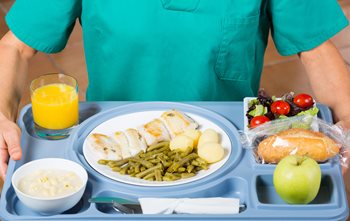
Nutrition and Hydration
For a complete list of accreditations for this course, please see the accreditation information box below the author’s bio. All states recognize our courses for accredited continuing nursing education, CNE, contact hours.
This Nutrition and Hydration continuing education course will provide participants with a review of the basic safety considerations and nutritional guidelines necessary to safely assist residents and elderly clients in eating, drinking and maintaining optimal nutritional status. This comprehensive review can be utilized for personnel throughout all healthcare settings, as the safety considerations for nutrition and hydration do not change according to level of acuity. Within this course, the participant will review the basics of nutrition and hydration, common nutritional problems of the elderly or ill, different ways that residents and clients can receive nutrition and hydration, aspiration precautions, food and beverage modification to prevent aspiration or choking, factors that influence food preferences, special diets, different types of adaptive equipment used for meals, making dining enjoyable for residents and clients, appropriately and safely feeding a resident or client, assisting residents and clients with disabilities during meal times, accurately measuring meal intake, improving communication to promote safety during meal times, steps to take in the event that a resident or client is observed to be choking, and completing incident reporting in a timely and thorough manner.
Questions? Check out our FAQs page and How Online IV Certification Works!
Objectives
Upon completion of this course, the participant will be able to:
- Discuss the basics of nutrition and hydration.
- Identify common nutritional problems of the elderly or ill.
- Discuss the different ways that residents and clients can receive nutrition and hydration.
- Define Aspiration Precautions.
- Explain how food and beverages can be modified to prevent aspiration or choking.
- Define special diets, and list the specific components of each.
- Identify different types of adaptive equipment used for meals.
- Describe factors that influence food preferences.
- Describe how to make dining enjoyable for residents and clients.
- Demonstrate how to appropriately and safely feed a resident or client.
- Explain how to assist residents and clients with disabilities during meal times.
- Demonstrate how to accurately measure meal intake.
- Explain how improving communication can promote safety during meal times.
- List the steps to take in the event that a resident or client is observed to be choking.
- Discuss how to complete incident reporting in a timely and thorough manner.
Curriculum
Chapter 1: Basics of Nutrition and Hydration
- Importance of Proper Nutrition and Hydration
- Water
- Carbohydrates
- Protein
- Fats
- Vitamins
- Minerals
- USDA’s MyPlate
Chapter 2: Common Nutritional Problems of the Elderly or Ill
- Considerations for Normal Changes of Aging
- Confusion, Dementia and Delirium
- Constipation
- Dentures, Tooth loss, and Mouth Pain
- Impaired Swallowing
- Unintended Weight loss
Chapter 3: Different ways Nutrition and Hydration Can Be Delivered
- Nutrition and Hydration by Mouth
- Nasogastric, Gastrostomy and Jejunostomy Tube Feeding and Hydration
- Intravenous Nutrition and Hydration
Chapter 4: Modified Food and Beverages to Prevent Aspiration and Choking
- Aspiration Precautions
- Thickened Liquids
- Modified Food Textures
Chapter 5: Special Diets
- Regular Diet
- Clear Liquid Diet
- Full Liquid Diet
- Mechanical Soft Diet
- Low Sodium Diet
- Fluid Restricted Diet
- Heart Healthy Diet
- Carbohydrate Controlled Diet
- Bland Diet
- Low Residue Diet
- High Residue Diet
- Gluten Free Diet
Chapter 6: Using Adaptive Equipment during Meals
- Clothing Protectors
- Adaptive Eating Utensils
- Adaptive Drinking Cups
- Plate Guards and Adaptive Bowls
Chapter 7: Making Meal Times Enjoyable for Residents and Clients
- Understanding Factors that Influence Food Preferences
- Strategies for Making Meal Times Enjoyable for Residents and Clients
Chapter 8: Feeding and Assisting Residents and Clients with Meals
- Feeding a Resident of Client that Cannot Feed Self
- Assisting Residents and Clients with Disabilities During Meal Times
Chapter 9: Measuring Meal Intake
- Calculating Basic Conversions
- Meal Consumed Percentages
Chapter 10: Improving Communication to Promote Safety
- Following the Resident Care Plan
- Alerting Resident, Visitors and Staff of Safety Precautions Related to Meals
Chapter 11: Responding to a Choking Resident or Client
- Identifying a Choking Victim
- Getting Help and Activating the Emergency Response System (911)
- Emergency Care for Resident or Client with an Obstructed Airway
Chapter 12: Incident Reporting
- Completing an Incident Report
Chapter 13: Skill Check-Off Lists
- Skill Check-Off Lists
Chapter 14: References
- California Bill 241
- Implicit Bias in Healthcare
- What is Implicit Bias?
- Implications of Implicit Bias in Healthcare
- How to Reduce Implicit Bias
Price: $18.00
Contact Hours: 1.5

Course Author

Damion Keith Jenkins
Damion Keith Jenkins is a Master’s Prepared Registered Nurse, NCLEX Prep Expert, Nurse Content Writer, Public Speaker & Nurse Entrepreneurship Coach, Skincare Expert & Nursing Professional Development Mentor that has a real passion for elevating the nursing profession! Damion is the owner and lead educator at The Nurse Speak – a nursing education and consulting company, blog & podcast, and he is the owner and lead skincare expert at RN Mobile Skincare in NYC.
Read Full BioCourse Accreditation
See our Accreditation Statements page to view our accreditation information.